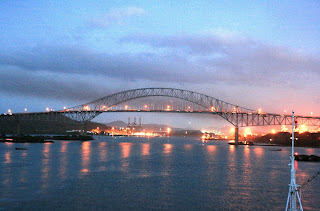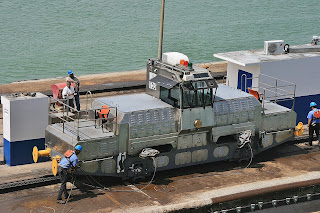The
canal, locks, and the story behind it were interesting. We were up early before
sunrise to get a good spot on the deck, not early enough for the front of the
bow on deck 7, but early enough for the front on deck 9.
Deck 9 people getting ready:
Deck 9 people getting ready:
It was just getting light when we went under the Bridge of the Americas. The Pan-American Highway crosses this bridge on its 19,000+ mile journey from Prudhoe Bay Alaska to Ushuaia Argentina (with a a number of branches up and down it's length). The highway has a 60 mile gap between Central and South America at marshlands called the Darien Gap.
Then on our way to the first locks:
Entering first lock:
Waiting on ship in front to clear second lock:
Now water in lock is being raised with water from second lock,
until they meet in the middle. See the little engine on the tracks on the left. More about them when we get to the locks on the Atlantic side.
Going into the second lock
Waiting for the water in the lock to match level of water in the lake:
And moving out into Miraflores lake (man-made):
Miraflores Lake:
To Pedro Miguel lock:
Paul went to the front of the bow for the this lock (a lot of people left).
Maybe dredging equipment:
And onto the Atlantic side locks.
Just before entering the lock, a crocodile:
First they get the cable from the ship:
Then they attach the cables to the mules:
I went to the side of the ship. Not much room in the canal, so the mules are necessary. The canal is 110 feet wide. The ship is 106 feet wide.
Then they attach the cables to the mules:
Now they tighten the cables. With mules pulling on each side of the ship, the ship will not bump against the sides of the canal:
I went to the side of the ship. Not much room in the canal, so the mules are necessary. The canal is 110 feet wide. The ship is 106 feet wide.
We then passed though to Limon Bay on the Atlantic side:


![Bridge-of-the-Americas--Panama-Canal-[3712a]](https://c6.staticflickr.com/8/7080/27409152205_400b61e42c.jpg)







































































No comments:
Post a Comment